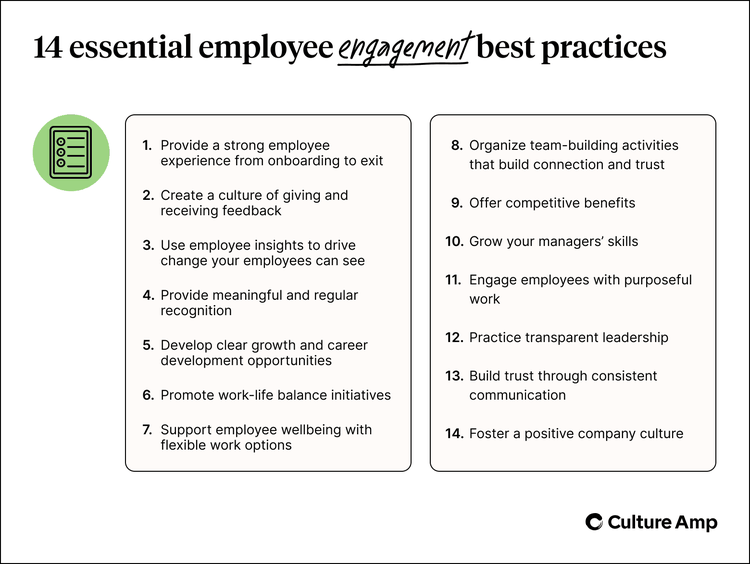
Article
Employee engagement doesn’t just happen – your business must carefully craft and nurture it over time. Building a motivated, productive, and engaged workforce requires years of effort, investment, and continuous refinement. It goes beyond perks and programs – the ultimate goal is to create an environment where people feel valued, connected, and inspired to work at their highest potential.
What’s the secret to better engagement? Every business has its own unique formula. To help you discover what works best for your organization, we’re sharing proven employee engagement best practices to help you create a workplace where every employee feels heard.
Employee engagement measures employees’ enthusiasm and commitment to your organization. At Culture Amp, we consider engagement a measure of the following five factors:
Our team of people scientists found that understanding and measuring these five components gives leaders the insights they need to make targeted improvements that boost engagement. When employees feel proud to work at a company they’d recommend, motivated to go above and beyond, and committed to staying for the long term, engagement soars – benefiting both individual performance and the organization’s overall success.

Wondering why it’s worth investing in employee engagement? A highly engaged workforce can have tremendous benefits for any organization. According to research by Gallup, it can boost productivity, reduce turnover, improve retention, and build a better company culture.
Here’s a closer look at these benefits and Gallup’s findings:
Employee engagement isn’t just a nice-to-have – it’s a strategic advantage that can fuel growth, drive innovation, and strengthen your company’s competitive edge. Now, let’s explore employee engagement best practices and strategies your business can use to build a better workplace.
Looking for ways to engage your workforce? Here are 14 employee engagement strategies for boosting morale and driving engagement.

Building a strong employee experience is essential to fostering an engaged workplace.
Employee experience encompasses everything an individual encounters throughout their journey with your company, from their new hire orientation and training to the support and development opportunities they receive during their tenure to their exit process. When organizations deliver a seamless and supportive experience at each stage of the employee lifecycle, employees feel valued and empowered to do their best work.
To help your business understand employee experience and measure engagement throughout the employee lifecycle, here are a few surveys and interview strategies you can use:
Together, these processes allow you to track and monitor engagement across three critical stages of the employee lifecycle: hiring, retention, and departure. When combined with other surveys – which we’ll explore in the next section – your business can gather valuable insights to continuously refine the employee experience and boost engagement.
Feedback is a crucial element in growth. It lets employees know what they’re doing well and highlights areas of opportunity they can use to grow personally and professionally. With Culture Amp’s Continuous Feedback and 360-Degree Feedback tools, your business can foster a culture of ongoing feedback, enabling growth conversations year-round rather than waiting for annual performance reviews.
Feedback should be a two-way street – employees need channels to share their thoughts and suggestions about their peers and leaders, as well as about the company in general.. Our people scientists have found that the most effective way to gather employee feedback is through regular surveys.
Conducting ongoing surveys – like engagement, pulse, diversity and inclusion, and manager effectiveness surveys – gives employees a platform to weigh in on key topics and helps your organization stay responsive to your employees’ needs and insights. By collecting, analyzing, and acting on these insights, your business can make targeted improvements that drive engagement and foster a more supportive and productive work environment.
Not sure what to ask in your surveys? Here are some sample employee engagement survey questions you can use to collect impactful, actionable feedback.
Collecting employee feedback only matters if you take action on it and drive meaningful change. Conducting regular employee surveys is important, but your workforce may get survey fatigue over time if they feel their feedback isn’t leading to real improvements.
How can you prove to employees that you’re listening? Here’s a three-step approach:
Together, these three steps help build lasting trust and accountability with your employees. You may also find that employees become more open with feedback and suggestions after seeing it lead to real changes or improvements.
Ensure your business takes quick action after every survey with these helpful tips for pulling actionable takeaways from employee engagement results.
Hearing that you’re doing a good job can do wonders for motivation, morale, and engagement. Yet, research has found that only 28% of employees feel meaningfully recognized at work.
To help your employees feel valued by their teams, managers, and the organization as a whole, your business needs to build a culture of appreciation. This can take the form of informal shout-outs in team meetings, private praise in 1-on-1 meetings, public awards like “Employee of the Month,” or one of the many ideas in our 20 employee recognition ideas that work article.
Introducing a peer-to-peer recognition tool, like Shoutouts, is a great way to make recognition a part of employees' everyday experience at your company. Culture Amp’s employee recognition software integrates directly with Slack and Microsoft Teams, so your employees can easily and quickly recognize their peers without having to log in to a separate system. This helps employees celebrate both big and small wins, giving their colleagues the recognition they deserve.
Employees are more likely to be engaged when they feel challenged and like they can grow their careers within your company, but Gallup found that only 1 in 4 employees are confident about their career path.
How can your business prioritize employee growth and ensure your employees see a future with your organization? Here are a few ideas:
You don’t need to implement every idea on this list to show employees your commitment to their growth, but each one is a powerful way to support their development and help them feel valued for the long term.
All work, all the time, isn’t sustainable. In fact, SHRM’s Employee Mental Health in 2024 research found that 44% of U.S. employees feel burned out at work. To support employee wellbeing and mental health, businesses must help employees maintain a healthy work-life balance.
Here are some practices that can promote work-life balance:
Benefits and workplace standards like these encourage employees to take the time off they need so they can return to work feeling refreshed and ready.
Another engagement initiative that supports employee wellbeing is flexible work. Flexible work allows employees to choose their own hours, work week, and sometimes even their work location, giving them the freedom to structure their day in a way that best fits their needs.
For example, an employee might choose to work from 8 a.m. to 2:30 p.m., pick up their kids and spend time with them after school, then return to work from 4 p.m. to 6:30 p.m. to wrap up tasks. Another employee might prefer to work four 10-hour days so they can take every Friday off.
Of course, managers and the business will need to approve employees' preferences, but when implemented effectively, flexible scheduling allows employees to tailor their workday to fit their needs. This fosters a culture of accountability while giving employees the autonomy to manage their responsibilities and personal lives, leading to greater job satisfaction and productivity.
Connection is crucial at work. In fact, Gallup research has shown that having a best friend at work can drive engagement and job success. To nurture these relationships, businesses must create opportunities for employees to connect with one another. This can be achieved through activities like volunteering events, happy hours, team offsites, lunches, and even just incorporating casual conversation into meetings.
Not sure how to bring together your remote employees? Check out our blog post, 25 fun virtual team-building activities that aren’t a happy hour, for some inspiration.
Offering a competitive benefits package is another way to keep employees engaged. Here are some key components and perks you may want to include in your package:
Employee needs and business resources are constantly evolving, so check in with employees regularly about which benefits they value and any new ones they'd like to see. This feedback ensures that your benefits package remains competitive and aligned with the needs of your workforce.
The most significant factor impacting an employee’s day-to-day experience at your company? Their manager.
Investing in continuous managerial training will help your managers develop the hard and soft skills they need to successfully lead and support their teams. Covering key topics like mitigating bias, leading with empathy, mastering delegation, resolving conflicts, and communicating change, equips managers with the tools they need to be better, more effective leaders.
Culture Amp’s Skills Coach tool makes learning quick and effective for even the busiest people managers. By delivering daily micro-learning content via Slack, email, or Microsoft Teams, Skills Coach gives managers short, interactive exercises that teach them the skills they need to build new behaviors and lasting habits – in less than two minutes a day.
Employees want to know their efforts are making a meaningful impact. One way to demonstrate this is by using cascading goals. This framework has goals flow from the top of an organization to departments, teams, and individuals, helping employees see and understand how their individual contributions align with the organization's success. When employees see how their daily actions matter, it gives them a greater sense of purpose and direction, which can drive productivity, engagement, and connection.
Employees want to know the challenges facing the business. When leaders are transparent about company goals, obstacles, and successes, employees feel more informed and involved in the organization’s success. This transparency fosters trust and team engagement, which can help organizations remain resilient, especially through times of change.
Consistent open and honest communication from leaders and managers builds trust and engagement within a team. When employees are regularly updated on company changes, goals, and progress, they feel more secure in their roles and more connected to the organization. This ongoing communication strengthens the relationship between employees and management, creating a more collaborative and supportive work environment.
Plus, communication goes both ways. Surfacing issues earlier allows for quicker resolution and a more proactive approach to problem-solving. It also fosters a culture of mutual trust and respect, building a better work environment for all employees.
Lastly, building a positive company culture is essential for your business. Company culture is the shared set of values, attitudes, and practices that define how an organization operates both internally and externally. As we like to say at Culture Amp, it’s "how we work – together."
Culture encompasses your company’s mission, values, and all the elements mentioned in this section, reflecting what your business stands for and how you care for your employees. While transforming company culture takes time, the best way to learn where improvements can be made is by asking your employees. Regularly survey your workforce, learn what they like and dislike, and take action on these findings. Over time, your culture will improve, creating a work environment that drives engagement.

Like most things, engagement ebbs and flows. Track employee engagement levels over time to see changes and highlight areas of opportunity. Monitoring these levels allows you to identify issues as they arise and measure the success of your engagement initiatives.
Here are a few KPIs your business can measure, monitor, and analyze to help you map changes in engagement and identify areas of improvement for your business.
Modern businesses have an abundance of data at their fingertips to track engagement trends and measure their impact. With the right tools, they can monitor everything from employee satisfaction to performance and employee development, painting a clear picture of how engaged their workforce is and where improvements can be made.
Check out our blog post, How to measure employee engagement, for a more in-depth look at the many ways to track employee engagement.
In addition to the employee engagement best practices outlined above, a comprehensive people experience platform is crucial to building a holistic view of employee engagement. Culture Amp People Analytics helps organizations turn data into action through analytics, customized surveys, and reporting tools that provide insights across every stage of the employee lifecycle. Culture Amp not only gives you metrics but also tailored recommendations, benchmarking data, and insights into engagement drivers, allowing you to identify areas for improvement and drive impact with action.
By leveraging Culture Amp, companies can continuously enhance their employee experience and drive engagement strategies that align with both employee and business goals.
Learn how Culture Amp can help you build a data-informed culture that boosts engagement.